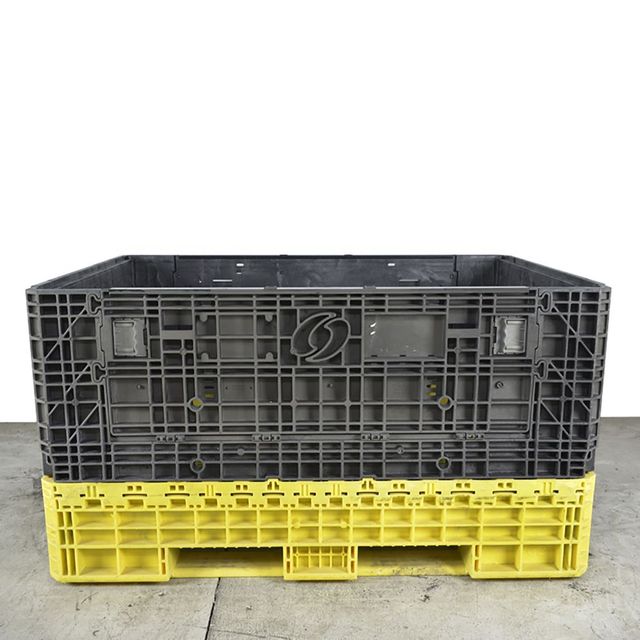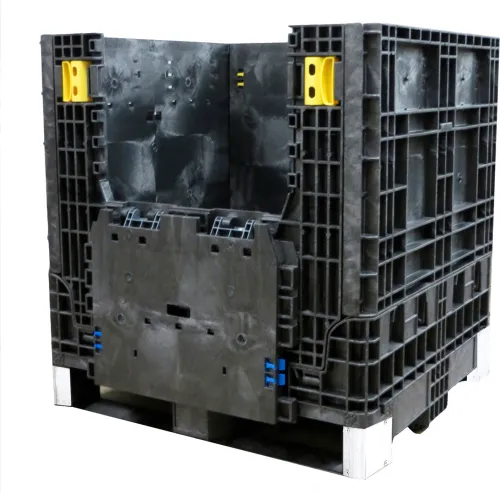The Ultimate Overview to Picking the Right Bulk Containers for Your Service Requirements
Selecting the suitable bulk containers is critical for any kind of business that relies upon effective logistics. Different kinds of containers exist, each created for particular materials and applications. Elements such as size, material compatibility, and governing standards play a significant role in this decision-making procedure. Recognizing these components can result in improved functional effectiveness. Nonetheless, numerous businesses ignore crucial facets that might improve their general effectiveness and sustainability. What are these considerations?
Comprehending Different Kinds of Bulk Containers
Bulk containers serve as important tools for organizations seeking effective storage and transportation remedies. These containers come in various kinds, each developed to satisfy specific functional requirements. One typical type is the intermediate bulk container (IBC), which is optimal for liquid and granulated products, using a balance of capacity and maneuverability. One more popular alternative is the mass bag, or FIBC, appropriate for dry, flowable products. These versatile containers are light-weight and can be easily transported and stored. For much heavier materials, rigid bulk containers are frequently employed, providing toughness and security for risk-free handling. In addition, there are specific containers customized for dangerous products, guaranteeing conformity with security guidelines. Understanding the unique features of these mass container kinds permits companies to make enlightened decisions that maximize logistics and minimize prices. By picking the appropriate container, companies can boost their operational efficiency and improve their supply chain procedures.
Key Material Factors To Consider for Bulk Containers
When selecting bulk containers, it is vital to consider the products made use of in their building. Variables such as chemical, resilience, and stamina compatibility play a crucial function in making certain the containers fulfill specific operational needs. In addition, weight and mobility worries can impact both performance and transportation logistics.
Product Resilience and Toughness
Resilience and stamina are critical consider choosing materials for mass containers, as they straight affect the container's capacity to hold up against different environmental problems and handling procedures. Products such as high-density polyethylene (HDPE), polypropylene, and stainless-steel are typically preferred for their durable buildings, offering resistance to abrasion, influence, and temperature level changes. The selection of product likewise affects the overall life expectancy of the container; more powerful materials commonly lead to less regular replacements, causing cost savings in time. In addition, the weight of the product can affect delivery costs and convenience of handling. Organizations have to consider their particular operational settings and the capacity for wear and tear to assure peak longevity and stamina in their bulk container choice.
Chemical Compatibility Aspects
Comprehending chemical compatibility is important for selecting bulk containers, as the products used should stand up to the particular compounds they will hold. Different elements affect compatibility, including the chemical nature of the contents, temperature level, and period of storage space. For instance, destructive chemicals might require containers made from stainless-steel or specialized plastics that stand up to degradation. Furthermore, responsive substances can generate warmth or gases, demanding vented or pressure-rated containers. The choice of container material, whether polyethylene, polycarbonate, or steel, should straighten with the chemical residential or commercial properties of the saved substances to avoid breaches or leakages. Ultimately, an extensive analysis of these compatibility aspects assures secure handling and storage, shielding both workers and the environment while maintaining product honesty.
Weight and Transportability Problems
Selecting mass containers entails not only evaluating chemical compatibility but likewise considering weight and mobility. Companies need to analyze the convenience of handling and transportation to enhance performance. Lightweight materials like high-density polyethylene (HDPE) or light weight aluminum can promote much easier motion and minimize shipping prices. On the other hand, heavier containers might offer improved sturdiness however can impede flexibility, specifically in settings needing constant relocation. Additionally, the style of the container need to enable for hassle-free training and stacking, ensuring ergonomic safety for employees. Business should likewise take into consideration the framework readily available for transport; for instance, containers suitable with forklifts or pallet jacks can simplify operations. Ultimately, the ideal equilibrium in between weight and portability straight affects operational performance and price effectiveness.
Sizing Your Bulk Containers for Optimum Effectiveness
When sizing mass containers, companies have to meticulously examine the measurements needed to suit their certain items. Furthermore, weight capacity is a crucial element that affects effectiveness and safety and security during transportation and storage. Effective sizing not just optimizes room but likewise optimizes functional workflows.
Determining Container Dimensions
Choosing the ideal measurements for mass containers is vital for taking full advantage of effectiveness in storage and transport. Organizations must analyze their specific needs, taking right into account elements such as used collapsible containers available space, the nature of the items being stored, and the methods of transport used. Exact dimensions guarantee that containers fit ideally in storehouses and cars, decreasing lost space and reducing handling time. Requirement dimensions can provide benefit, but custom-made measurements may be essential for one-of-a-kind demands or to accommodate details items. Additionally, it is very important to assess piling abilities and ease of access, as these variables influence overall functional effectiveness. Inevitably, the right dimensions lead to boosted organization and structured logistics, benefiting the general efficiency of business.
Weight Ability Considerations
Understanding weight ability is crucial for companies intending to optimize their bulk container efficiency. The weight capability of a container straight affects storage abilities, transport logistics, and overall operational costs. Selecting containers with the suitable weight restrictions ensures that companies can securely keep and deliver their items without risking damage or conformity problems. Overwhelming containers can bring about architectural failings, while underutilizing capability cause wasted resources. When choosing containers, it is vital for organizations to assess their item weights and think about any type of regulatory demands. Furthermore, aspects such as the type of material, intended use, and ecological conditions ought to additionally influence weight capability choices. By reviewing these aspects, companies can improve effectiveness and ensure a streamlined supply chain.
Regulatory Conformity and Safety And Security Standards

Regulative conformity and safety standards play a crucial role in the selection of bulk containers for services. Organizations should ensure that their containers meet numerous regulations established by regional, national, and global authorities. These requirements often relate to product security, structural stability, and correct labeling, which help avoid crashes and ensure the secure transportation of goods.
In addition, adherence to industry-specific standards, such as those from the Food and Medication Administration (FDA) or the Occupational Safety And Security and Health Administration (OSHA), is essential for firms handling harmful materials or food products. Non-compliance can lead to penalties, legal problems, or damages to a business's online reputation.
Services must also consider the container's compatibility with the materials being stored or transported to stay clear of contamination or chain reaction (used collapsible containers). To summarize, recognizing and carrying out governing compliance and security standards is crucial for the liable and efficient use bulk containers
Sustainability Options for Eco-Friendly Mass Containers

Firms are also exploring alternatives made from recycled products, which not just save sources however additionally support the recycling industry. Moreover, innovations in style enable lighter containers that need less energy to transport, additionally improving sustainability. By integrating these green bulk container options, services can demonstrate their dedication to environmental stewardship while satisfying consumer demand for sustainable methods. This change not just aids the world but can also enhance brand track record and client loyalty.
Cost-Effectiveness and Budgeting for Mass Containers
While many services focus on sustainability, cost-effectiveness stays a vital factor when choosing mass containers. Organizations should assess the initial acquisition price, in addition to long-lasting functional prices, to ensure monetary stability. Factors such as upkeep, reusability, and durability play a substantial function in establishing total expenditures.
Purchasing high-grade containers may yield greater upfront prices yet can lead to cost savings via reduced substitute rates and lowered waste. Additionally, companies must consider transportation expenses and storage efficiency, as these can impact the overall budget.

Regularly Asked Inquiries
Just how Do I Identify the Right Container for Hazardous Products?
To determine the appropriate container for unsafe materials, one need to examine compatibility with the material, consider the container's product, check for regulatory compliance, and analyze capability and safety functions to guarantee correct handling and storage.
Can Mass Containers Be Personalized for Specific Products?
Yes, bulk containers can be personalized for particular products. refurbished bulk containers. Numerous attributes, such as dimension, material, and layout, can be customized to meet special requirements, ensuring ideal safety and security and efficiency for carrying and storing various products
What Is the Typical Lifespan of Various Mass Container Types?
The average lifespan of mass container types varies; plastic containers last 5-10 years, steel containers 10-20 years, and wooden containers normally last 3-7 years, relying on use, upkeep, and environmental problems.
How Should I Tidy and Maintain Mass Containers?
To clean up and keep bulk containers, one need to frequently examine for damage, get rid of deposit, clean with proper detergents, wash thoroughly, and warranty correct drying prior to storage space. Following supplier standards improves longevity and safety and security during use.
Exist Rental Options for Bulk Containers Available?
Yes, various firms provide rental alternatives for mass containers, offering versatility for businesses. These rentals can suit numerous requirements, allowing business to take care of inventory effectively without the dedication of purchasing containers outright.
Toughness and stamina are important aspects in selecting materials for mass containers, as they straight affect the container's capacity to withstand numerous environmental conditions and taking care of processes. Understanding chemical compatibility is necessary for choosing mass containers, as the materials used have to stand up to the certain materials they will certainly hold. Understanding weight ability is essential for businesses intending to optimize their bulk container effectiveness. Governing conformity and safety and security requirements play an essential role in the selection of bulk containers for companies. While several services concentrate on sustainability, cost-effectiveness stays an essential variable when choosing bulk containers.